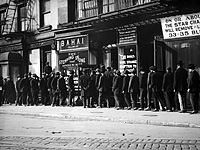New York City’s share of poor people appears to have plateaued since the recession, at 21.4 percent, with more people working in 2012 than the year before, but at lower wages, according to a new city study. Contributing to the city’s economic problems were increases in the number of Asian-Americans, immigrants and residents of Queens slipping into poverty.

Unemployed men queuing for coffee and bread at a soup kitchen run by the Bahai Fellowship at 203 East 9th Street, New York, circa 1930.
But under a broader definition of poverty that the city applies, the picture remains grim for a far larger number of New Yorkers.
As in 2011, 46 percent, or nearly half of New Yorkers, were making less than 150 percent of the poverty threshold, a figure that describes people who are struggling to get by.
Even with fewer people unemployed, the poverty rate for working-age adults working full time reached 8 percent, by the city’s measure. Fully 17 percent of families with a full-time worker lived in poverty, and even among families with two full-time workers, the rate was 5.2 percent.
The latest numbers, compiled by the city’s Center for Economic Opportunity, were presented to the City Council on Tuesday and are to provide a base line for how well Mayor Bill de Blasio addresses a signature issue.
“This is an administration that got elected almost entirely on this question,” said Anthony E. Shorris, the first deputy mayor.
“After years of trying to nibble around the edges with pilot programs that were well-intentioned, but that were not moving the needle,” he said, the de Blasio administration would confront “this stubborn undercurrent” full throttle through paid sick leave, expansion of the so-called living wage law, municipal identification cards, universal prekindergarten and after-school programs.
“Everything we’re trying to do is at scale,” he said.
The report concluded that “the recession-related growth in the poverty rate, which began in 2008, has ended.”
Still, some groups, some of them overlapping, plunged deeper into poverty. Since 2008, when the city initiated its more comprehensive poverty index, Asians overtook Hispanics as the poorest New Yorkers. In 2008, they were statistically identical at about 23 percent. By 2012, the rate among Asians was 3.3 percentage points higher than the rate for Hispanics, at 29 percent.
Under the less exacting federal standard, a family of two adults and two children was defined as poor in 2012 if it made less than $23,283, yielding a poverty rate of 20 percent in the city. But under the city’s definition, which takes into account benefits like food stamps and expenses like higher living costs, the income threshold was $31,039, resulting in a rate of 21.4 percent.
A smaller proportion of people (5.4 percent) were living in extreme poverty — below 50 percent of the poverty rate — by the city’s standard than under the federal standard (8.1 percent).
While more people were working, wages were lagging because most jobs were generated in lower-wage hospitality and retail fields.
Brooklyn was the only borough to register a decline in its poverty rate between 2011 and 2012.
Compared with the federal measure, the city showed lower poverty rates among people under 18 and higher rates among those 65 and older. The city’s measure, according to Christine D’Onofrio, the lead researcher, also demonstrated the effects of housing subsidies, an earned-income tax credit and food stamps in keeping people out of poverty and the high cost of medical care in swelling the ranks of the poor.
But the most striking detail remained the 46 percent at or near poverty, the same rate found in a report last year that was prepared by Dr. Mark K. Levitan when his son, Dan, was, coincidentally, Mr. de Blasio’s communications director. Dr. Levitan was the Center for Economic Opportunity’s director of poverty research before retiring.
The report outlined the de Blasio administration’s agenda for mitigating poverty: municipal identification cards to provide immigrants with access to basic services and other supports, raising the local minimum wage, protecting low-wage workers, giving preferential treatment to city residents in public works jobs, raising wages at companies doing business with or receiving subsidies from the city, and more school services that also allow parents to work.
Poverty will never be eliminated, said Lilliam Barrios-Paoli, the deputy mayor for health and human services. “There will always be relative poverty, but it’s not acceptable when people are mired in abject poverty,” she said.
“Obviously,” Mr. Shorris said, “poverty is reflective of larger national and global phenomena.”
“We’re not unrealistic about what a city can do,” he added. “But after four years, we’ll be asking whether our interventions were effective in changing what would have been the course of poverty in New York. What would the city have looked like had we not made those interventions?”









